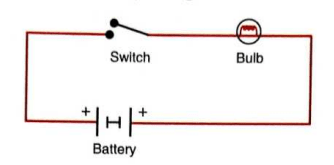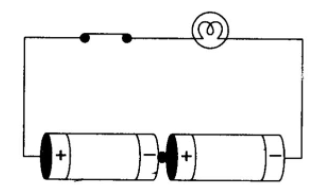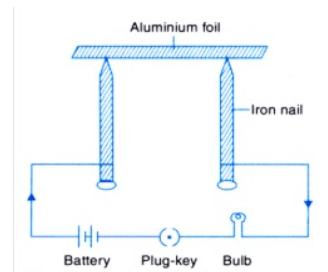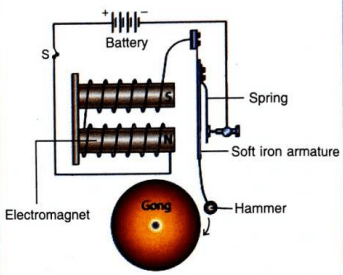Are you looking for DAV Books Solutions then you are in right place, we have discussed the solution of Science class 7 book Chapter 17 Electric Current and Its Effects which is followed in all DAV School Solutions are given below with proper Explanation please bookmark our website for further updates!! All the Best !!
DAV Class-7 Electric Current and Its Effects Question and Answer
Something To Know
A. Fill in the blanks.
1. When current is switched on, an electric fan converts electric energy (mainly) into mechanical energy.
2. When current is switched ‘on’ in a room heater, it converts electric energy into heat energy.
3. We prefer a wire of nichrome for making the heating element in domestic appliances like the electric iron, electric heater and the electric toaster.
4. A safety device, based on the heating effect of current is the electric fuse .
5. Electromagnet should show rapid magnetic field when the current is switched ON.
B. Write True or False for the following statements.
Ans:
| 1. An electric current can produce a heating effect but not a magnetic effect. | False |
| 2. The heating coils/elements of different electrical appliances are usually made from copper or aluminium wires. | False |
| 3. When the current through a fuse wire exceeds its specified value, the fuse wire melts and breaks. | True |
| 4. Connecting many devices in a single socket is not likely to cause any problem in a circuit. | False |
| 5. The strength of an electromagnet can be increased by decreasing the number of turns of its coil. | False |
C. Tick the correct option.
1. When electric current flows through a filament of electric bulb, the filament gives out–
Ans 1: both heat and light energy
2. A fuse wire is a wire of-
Ans 2: low resistivity and low melting point.
3. We are more likely to observe a strong magnetic effect with a-
Ans 3: current carrying circular coil of many turns wound on a soft iron core.
4. A common household device, that uses an electromagnet in its working, is-
Ans 4: the electric bell
5. A good electromagnet would-
Ans 5: act like a magnet when the current is ‘ON’ but would not do so when the current is ‘OFF’.
D. Answer the following questions in brief.
1. The bulb in the circuit shown in figure does not glow. Why? Redraw the circuit diagram by making the necessary changes in it, so that the bulb starts glowing.

Ans 1: The bulb in the circuit shown in the figure does not glow because the switch is in off position and the cells are not connected properly.

2. Name three practical devices based on the heating effect of current.
Ans 2: (i) Electric iron (ii) geyser (iii) Electric heater
3. Write two special characteristics of the wire needed for making the ‘element’ of an electric heater.
Ans 3: The two special characteristics of the wire are –
- It should have high resistivity.
- It should have high melting point.
4. Give the meaning of the terms ‘short circuiting’ and ‘overloading’ in an electric circuit?
Ans 4: overloading: connection of more than one device/appliance to a single socket.
short circuit: touching of the live and neutral wire, due to faulty insulation.
5. Do you think an electromagnet can be used for separating plastic bags from a garbage heap? Explain.
Ans 5: An electromagnet cannot be used for separating plastic bags from a garbage heap because plastics are non-magnetic materials. So, it will not attract by the magnet.
6. State any three applications of an electromagnet.
Ans 6: Three applications of an electromagnet are –
a) Electromagnets are used in electric bells and loudspeakers.
b) It is also used in mobile cranes to lift and transfer heavy iron rods & machinery.
c) Many toys also have electromagnets inside them.
E. Answer the following questions.
1. The same amount of current flows through the connecting wires and the bulb filament. However, it is only the filament that glows. Why?
Ans 1: The metal filament of an electric bulb is usually made up of tungsten wire which has very high resistance therefore it becomes red hot and start glowing. While connecting wire has low resistance thus it does not heated up.
2. The brightness of light, emitted by a bulb, is observed to decrease when an electric heater is connected in series with it. Suggest the likely reason for this observation.
Ans 2: The brightness of light, emitted by a bulb, is observed to decrease when an electric heater is connected in series with it because voltage across the bulb decreases as compared to the previous situation.
3. Suggest an experimental set up to illustrate the action of an electric fuse.
Ans 3: Take two nails and connect them in the circuit shown in the diagram. Connect the top of nails with aluminium wire and then turn on the switch. As the current start flowing in the circuit, the aluminium wire burns quickly. This is the way; an electric fuse works.

4. A novice electrician, while carrying out some repairs in Sumit’s house, tried to put a piece of tungsten wire in a ‘fuse. Sumit’s father, on noticing this, stopped him from doing so. Give reasons as to why he did that.
Ans 4: Tungsten should not be used in the fuse because it has very high melting point. A fuse should have low melting point so that it can burn up when the current exceeds the normal limit.
5. Draw a labelled diagram of an electric bell and explain its working.
Ans 5: labelled diagram of an electric bell

Working of an electric bell
- When current flows through the electromagnet it acquires magnetism and attract the armature.
- As the armature bends towards the electromagnet, the gong is struck. But at the same time contact between armature and contact screw gets broken and the circuit gets switched off.
- As the current flow stops, the electromagnet loses it magnetism. It, therefore, no longer attracts the armature.
- The armature gets pulled back to its original position by spring action. It, now, again comes in contact with the contact screw; the circuit gets completed again. The cycle repeats itself and the gong gets struck again. This, in turn, again breaks the circuit.
1 thought on “Chapter 17 | Electric Current and Its Effects | Class-7 DAV Science Solutions”